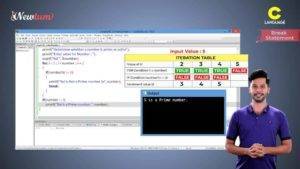In this blog, we will explore the logic and operation of a Python program to find the last element of a list using for loop. We will delve into the code step by step, explaining each component and its purpose. By understanding this process, you will gain insights into how lists work and how to access specific elements within them.
In Python, working with lists is a common task, and often we need to access specific elements of a list based on their position. One such scenario is retrieving the last element of a list. While Python provides various built-in functions and methods to manipulate lists, understanding the underlying logic and operation can enhance our programming skills and enable us to write more efficient and customized code.
So, let’s dive into the code and find the last element of a ist in Python using for loop.
Python Program to Find the Last Element of a List Using for Loop
# Get the Last Element of the List in python Using For loop
# input list
inputList = [5, 1, 6, 8, 3]
# printing input list
print("Input list:", inputList)
# Traversing till the length of the list
for k in range(0, len(inputList)):
# Checking whether the iterator value is equal to the length of list -1(last element)
# Here == is used to check whether the iterator value is equal to list length-1
if k == (len(inputList)-1):
# Printing the corresponding element of the list,
# if the condition is true
print("Last element of the input list = ", inputList[k])
Code Logic Explanation
Defining the Input List
We start by defining an input list that contains multiple elements. This list will be used to demonstrate the retrieval of the last element.
Printing the Input List
Before proceeding with the loop, we print the input list to provide a visual representation of the data we are working with.
Traversing the List Using a For Loop
We use a for loop to iterate through the input list. The loop iterates over a range of indices starting from 0 to the length of the list.
Checking for the Last Element
Inside the loop, we check whether the current iterator value k is equal to the length of the list minus 1. This condition ensures that we are accessing the last element of the list.
Printing the Last Element
If the condition inside the loop is true, we print the corresponding element of the list, which is the last element.
Output:
Input list: [5, 1, 6, 8, 3]
Last element of the input list = 3The program takes an input list [5, 1, 6, 8, 3] and prints it. Then, it iterates through the list using a for loop. During each iteration, it checks if the current iterator value is equal to the length of the list minus 1, which represents the last element. In this case, the last element of the input list is 3. The program successfully identifies it and prints the message “Last element of the input list = 3” as the output.
In Python, there are multiple ways to retrieve the last element of a list. Here are a few alternative methods:
Using Negative Indexing:
Python supports negative indexing, where -1 refers to the last element, -2 refers to the second-to-last element, and so on. You can directly access the last element of a list using negative indexing, like last_element = inputList[-1]. This method is concise and efficient.
Using List Slicing:
List slicing allows you to extract a portion of a list by specifying start and end indices. To retrieve the last element, you can use list slicing with an index range that includes only the last element, like last_element = inputList[-1:]. This method returns a new list containing only the last element.
Using the pop() Method:
The pop() method in Python removes and returns the last element of a list. By invoking inputList.pop(), you can retrieve the last element directly. However, note that this method modifies the original list by removing the last element.
Using the [-1] Indexing Method:
Similar to negative indexing, you can directly access the last element using inputList[-1]. This method is concise and widely used in Python.
We used the For Loop method in the code as it provides a more explicit and readable approach, making it easier to understand the intention of the code. It explicitly iterates through the entire list, checking for the last element by comparing the iterator value to the length of the list minus one. This method is beneficial when you want to perform additional operations or condition checks within the loop.
While the alternative methods are more concise, they might not offer the same level of clarity and explicitness, especially when you are new to Python or working in a collaborative environment where code readability is crucial. The For Loop method provides a structured and intuitive way to handle list traversal and identify the last element, enhancing the code’s comprehensibility and maintainability.
Conclusion
In this tutorial, the code presented demonstrates a simple yet effective method for retrieving the last element of a list using a for loop in Python. By iterating through the list and checking for the last element, we can easily access and print the desired value. Understanding the logic and operation of this code allows us to work with lists more efficiently and access specific elements based on our needs.
By mastering this technique, Python programmers can enhance their ability to process and manipulate lists effectively, improving their overall programming skills. Whether it’s retrieving the last element or performing other list operations, this code demonstrates the power and versatility of Python’s loop constructs.
Frequently Asked Questions
Q: What is the purpose of the if condition inside the loop?
A: The if condition checks whether the current iterator value k is equal to the length of the list minus 1. This condition ensures that we are accessing the last element of the list.
Q: Can this code be used for lists of any length?
A: Yes, the code can handle lists of any length. It dynamically checks for the last element based on the current length of the list.
Q: Is it possible to modify the code to access the second-to-last element instead?
A: Yes, by adjusting the condition in the code, you can modify it to retrieve any element based on its position in the list.
Q: What if the input list is empty?
A: If the input list is empty, the loop will not execute as there are no elements to iterate over. Therefore, no output will be produced.
Q: Can this code be used for lists containing different data types?
A: Yes, the code works for lists of any data type. It focuses on the position within the list, regardless of the values stored in the elements.



